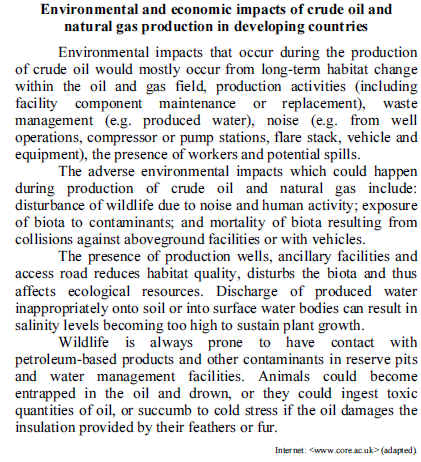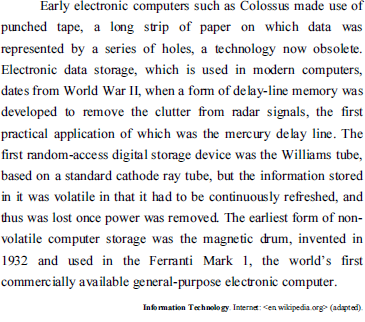Text genres bring components that suit their social use. In the introduction to Puff Daddy’s famous album “No way out”, we observe identification with the genre prayer, mainly because the author employs a text sequence that is:
Point out the verb form to suit the captioned image.

Based on the texts CB1A2-I and CB1A2-II, judge the following item.
In the text CB1A2-II, the boss suggests that his human employee is not very competent and reliable, which is why he brings a sophisticated robot to take his place.

Based on the previous text, judge the following item.
According to the text, the more technology improved and the more electric trains took over from steam-powered ones, the deeper the lines went.
The text suggests that the pain caused for ordinary people by rising oil prices may worsen in the near future.
It is correct to conclude that the text emphasizes how agricultural production may be badly affected by higher salinity levels.
The text suggests that the pain caused for ordinary people by rising oil prices may worsen in the near future.

Based on the text, judge the following items.
The last period of the text could be correctly rewritten, without this changing its meaning, as Animals would, then, become entrapped in the oil and drown, or ingest toxic quantities of oil, or succumb to cold stress if the oil damages the insulation provided by their feathers or fur.
Internal audit’s role in ESG reporting
Conversations and focus on sustainability, typically grouped into environmental, social and governance (ESG) issues, are quickly evolving — from activist investor groups and inquisitive regulators pushing for change to governing bodies and C-suite executives struggling to understand and embrace the concept. At the forefront of this new risk area is pressure for organizations to make public commitments to sustainability and provide routine updates to ESG-related strategies, goals, and metrics that are accurate and relevant. However, ESG reporting is still immature, and there is not a lot of definitive guidance for organizations in this space. For example, there is no single standard for what should be reported.
What is clear is that strong governance over ESG — as with effective governance overall — requires alignment among the principal players as outlined in The Internal Institute of Auditors (IIA) Three Lines Model. As with any risk area, internal audit should be well-positioned to support the governing body and management with objective assurance, insights, and advice on ESG matters.
Embarking on the ESG journey
Efforts to mitigate the accelerating effects of climate change and address perceived historical social inequities are two powerful issues driving change globally. These movements have enhanced awareness of how all organizations impact, influence, and interact with society and the environment.
They also have spurred organizations to better recognize and manage ESG risks (i.e., risks associated with how organizations operate in respect to their impact on the world around them). This broad risk category includes areas that are dynamic and often driven by factors that can be difficult to measure objectively.
Still, there is growing urgency for organizations to understand and manage ESG risks, particularly as investors and regulators focus on organizations producing high-quality reporting on sustainability efforts. What’s more, that pressure is being reflected increasingly in executive performance as more organizations tie incentive compensation metrics to ESG goals.
As ESG reporting becomes increasingly common, it should be treated with the same care as financial reporting. Organizations need to recognize that ESG reporting must be built on a strategically crafted system of internal controls and accurately reflect how an organization’s ESG efforts relate to each other, the organization’s finances, and value creation.
Internal audit can and should play a significant role in an organization’s ESG journey. It can add value in an advisory capacity by helping to identify and establish a functional ESG control environment. It also can offer critical assurance support by providing an independent and objective review of the effectiveness of ESG risk assessments, responses, and controls.
Source: Adapted from https://na.theiia.org/about-ia/PublicDocuments/WhitePaper-Internal-Audits-Role-in-ESG-Reporting.pdf
( ) One of the hurdles of ESG issues is that they have been restricted to a single group of experts.
( ) There has been such a great demand for publicizing government efforts towards ESG that reports have become accurate and systematized.
( ) Part of the internal auditor’s job is to be knowledgeable enough in the area of ESG so as to be able to provide solid guidance to those in charge of the administration.
The statements are, respectively:
In May 2021, a hole was found in a robotic arm aboard the International Space Station (ISS). The suspected culprit was a piece of rogue space junk. While thankfully no astronauts were injured, it has re-focussed attention on the growing problem of orbital debris.
How did we get here?
It’s easy to forget that just seven decades ago the Moon was the only thing orbiting the Earth. On 1 January 2021 there were 6,542 satellites in orbit. Tellingly, only just over half of them were active. That’s a lot of useless metal careering around the planet at 28,000 kph — ten times faster than a bullet.
How bad is the problem?
Very bad and getting worse. Estimates suggest there are currently half a million pieces of debris the size of a marble or larger and 100 million pieces of debris above one millimeter across. Yet only 27,000 pieces are actively tracked by the US Department of Defense.
What is Kessler syndrome?
It’s a catastrophic chain of events in which a satellite is shattered by a piece of space junk (or a collision with another satellite) and the resulting debris destroys more satellites creating more junk and so on in a never-ending cascade. It’s a domino effect – one piece falls and then takes the rest with it – and is named after NASA scientist Donald Kessler, who outlined the dangers back in 1978.
What can we do about it?
Better regulation of new launches would help, as right now it’s a bit of a free-for-all. There are existing regulations in place to try and mitigate the dangers, such as a 25-year de-orbit rule for missions in low-Earth orbit. However, ESA’s Space Debris Environment Report says that less than 60 per cent of those flying in low-Earth orbit currently stick to the rules.
Colin Stuart. Space Junk: Is it a disaster waiting to happen?
Internet: <www.sciencefocus.com> (adapted)
It can be concluded that in the beginning of the fourth paragraph, “It's” is the contracted form of it has
In May 2021, a hole was found in a robotic arm aboard the International Space Station (ISS). The suspected culprit was a piece of rogue space junk. While thankfully no astronauts were injured, it has re-focussed attention on the growing problem of orbital debris.
The event described in the first paragraph is an example of an effect whose risks were predicted decades ago
Considering the text above, judge the following item.
According to the text, before 1932, information could only be stored provisionally in digital form.

Considering the text above, judge the following item
The verb “removed” (third sentence) can be adequately replaced with taken out.
Here’s why we’ll never be able to build a brain in a computer
It’s easy to equate brains and computers – they’re both thinking machines, after all. But the comparison doesn’t really stand up to closer inspection, as Dr. Lisa Feldman Barrett reveals.
People often describe the brain as a computer, as if neurons are like hardware and the mind is software. But this metaphor is deeply flawed.
A computer is built from static parts, whereas your brain constantly rewires itself as you age and learn. A computer stores information in files that are retrieved exactly, but brains don’t store information in any literal sense. Your memory is a constant construction of electrical pulses and swirling chemicals, and the same remembrance can be reassembled in different ways at different times.
Brains also do something critical that computers today can’t. A computer can be trained with thousands of photographs to recognise a dandelion as a plant with green leaves and yellow petals. You, however, can look at a dandelion and understand that in different situations it belongs to different categories. A dandelion in your vegetable garden is a weed, but in a bouquet from your child it’s a delightful flower. A dandelion in a salad is food, but people also consume dandelions as herbal medicine.
In other words, your brain effortlessly categorises objects by their function, not just their physical form. Some scientists believe that this incredible ability of the brain, called ad hoc category construction, may be fundamental to the way brains work.
Also, unlike a computer, your brain isn’t a bunch of parts in an empty case. Your brain inhabits a body, a complex web of systems that include over 600 muscles in motion, internal organs, a heart that pumps 7,500 litres of blood per day, and dozens of hormones and other chemicals, all of which must be coordinated, continually, to digest food, excrete waste, provide energy and fight illness.[…]
If we want a computer that thinks, feels, sees or acts like us, it must regulate a body – or something like a body – with a complex collection of systems that it must keep in balance to continue operating, and with sensations to keep that regulation in check. Today’s computers don’t work this way, but perhaps some engineers can come up with something that’s enough like a body to provide this necessary ingredient.
For now, ‘brain as computer’ remains just a metaphor. Metaphors can be wonderful for explaining complex topics in simple terms, but they fail when people treat the metaphor as an explanation. Metaphors provide the illusion of knowledge.
(Adapted from https://www.sciencefocus.com/future-technology/can-we-build-brain-computer/ Published: 24th October, 2021, retrieved on February 9th, 2022)
The title of the text implies that the author will:





